Modeling of Fiber-Constrained Planar PVC Gel Actuators
Abstract
:1. Introduction
2. Methodology
2.1. Modeling of PVC Gel Deformation
2.2. The Model of the Proposed Planar Actuator
2.3. The Amoeba-like Deformation Mechanism of PVC Gels
3. Experimental Section
3.1. Materials
3.2. Preparation of PVC Gel Membrane
3.3. Preparation of Fiber-Constrained Planar PVC Gel Actuators
3.4. Experimental Set
4. Results and Discussion
5. Conclusions
Author Contributions
Funding
Institutional Review Board Statement
Informed Consent Statement
Data Availability Statement
Conflicts of Interest
References
- Miriyev, A.; Stack, K.; Lipson, H. Soft material for soft actuators. Nat. Commun. 2017, 8, 596. [Google Scholar] [CrossRef] [PubMed]
- Mirvakili, S.M.; Hunter, I.W. Artificial Muscles: Mechanisms, Applications, and Challenges. Adv. Mater. 2018, 30, 1704407. [Google Scholar] [CrossRef] [PubMed]
- Mirvakili, S.M.; Hunter, I.W. Fast Torsional Artificial Muscles from NiTi Twisted Yarns. ACS Appl. Mater. Interfaces 2017, 9, 16321–16326. [Google Scholar] [CrossRef] [PubMed]
- McCracken, J.M.; Donovan, B.R.; White, T.J. Materials as Machines. Adv. Mater. 2020, 32, 1906564. [Google Scholar] [CrossRef] [PubMed]
- Kellaris, N.; Venkata, V.G.; Smith, G.M.; Mitchell, S.K.; Keplinger, C. Peano-HASEL actuators: Muscle-mimetic, electrohydraulic transducers that linearly contract on activation. Sci. Robot. 2018, 3, eaar3276. [Google Scholar] [CrossRef]
- Lee, J.; Zambrano, B.L.; Woo, J.; Yoon, K.; Lee, T. Recent Advances in 1D Stretchable Electrodes and Devices for Textile and Wearable Electronics: Materials, Fabrications, and Applications. Adv. Mater. 2020, 32, e1902532. [Google Scholar] [CrossRef]
- Ma, S.; Zhang, Y.; Liang, Y.; Ren, L.; Tian, W.; Ren, L. High-Performance Ionic-Polymer–Metal Composite: Toward Large-Deformation Fast-Response Artificial Muscles. Adv. Funct. Mater. 2020, 30, 1908508. [Google Scholar] [CrossRef]
- Zhao, Y.; Yin, L.; Zhong, S.; Zha, J.; Dang, Z. Review of dielectric elastomers for actuators, generators and sensors. IET Nanodielectrics 2020, 3, 99–106. [Google Scholar] [CrossRef]
- Maity, C.; Das, N. Alginate-Based Smart Materials and Their Application: Recent Advances and Perspectives. Top. Curr. Chem. 2021, 380, 3. [Google Scholar] [CrossRef]
- Li, B.; Chang, L.; Wang, Y. Modeling of Dielectric Gel Using Multi-physics Coupling Theory. In Soft Actuators: Materials, Modeling, Applications, and Future Perspectives; Springer: Singapore, 2019; pp. 561–580. [Google Scholar] [CrossRef]
- Li, Y.; Guo, M.; Li, Y. Recent advances in plasticized PVC gels for soft actuators and devices: A review. J. Mater. Chem. C 2019, 7, 12991–13009. [Google Scholar] [CrossRef]
- Li, Y.; Hashimoto, M. PVC gel based artificial muscles: Characterizations and actuation modular constructions. Sens. Actuators A Phys. 2015, 233, 246–258. [Google Scholar] [CrossRef]
- Cheng, X.; Yang, W.; Cheng, L.; Yan, H.; Jiao, Z. Tunable-focus negative poly(vinyl chloride) gel microlens driven by unilateral electrodes. J. Appl. Polym. Sci. 2018, 135, 46136. [Google Scholar] [CrossRef]
- Ko, H.-U.; Kim, H.C.; Kim, J.W.; Park, J.; Kim, J. Soft piezoelectric polymer of poly[di(ethylene glycol) adipate] plasticized poly vinyl chloride and its strain sensing. Mater. Lett. 2018, 227, 276–280. [Google Scholar] [CrossRef]
- Li, Y.; Hashimoto, M. PVC gel soft actuator-based wearable assist wear for hip joint support during walking. Smart Mater. Struct. 2017, 26, 125003. [Google Scholar] [CrossRef]
- Park, W.-H.; Shin, E.-J.; Yun, S.; Kim, S.-Y. An Enhanced Soft Vibrotactile Actuator Based on ePVC Gel with Silicon Dioxide Nanoparticles. IEEE Trans. Haptics 2018, 11, 22–29. [Google Scholar] [CrossRef]
- Lan, C.; Zhou, Z.; Ren, H.; Park, S.; Lee, S.H. Fast-response microlens array fabricated using polyvinyl chloride gel. J. Mol. Liq. 2019, 283, 155–159. [Google Scholar] [CrossRef]
- Feng, X.; Li, Q.; Wang, K. Waste Plastic Triboelectric Nanogenerators Using Recycled Plastic Bags for Power Generation. ACS Appl. Mater. Interfaces 2021, 13, 400–410. [Google Scholar] [CrossRef]
- Wang, Z.; Wang, Y.; Wang, Z.; He, Q.; Li, C.; Cai, S. 3D Printing of Electrically Responsive PVC Gel Actuators. ACS Appl. Mater. Interfaces 2021, 13, 24164–24172. [Google Scholar] [CrossRef]
- He, Q.; Pan, H.; Zhao, Z.; Zhang, H.; Yin, G.; Wu, Y.; Cai, L.; Yu, M.; Duan, J.; Shen, Q.; et al. Polyvinyl chloride gel based electro-active switchable bio-inspired adhesive. Compos. Part A Appl. Sci. Manuf. 2022, 163, 107180. [Google Scholar] [CrossRef]
- Dong, C.; Zhu, Z.; Li, Z.; Shi, X.; Cheng, S.; Fan, P. Design of fishtail structure based on oscillating mechanisms using PVC gel actuators. Sens. Actuators A Phys. 2022, 341, 113588. [Google Scholar] [CrossRef]
- Xia, H.; Hirai, T. Space charge distribution and mechanical properties in plasticized PVC actuators. In Proceedings of the 2009 International Conference on Mechatronics and Automation, Changchun, China, 9–12 August 2009; pp. 164–169. [Google Scholar]
- Asaka, K.; Hashimoto, M. Electrical properties and electromechanical modeling of plasticized PVC gel actuators. Sens. Actuators B Chem. 2018, 273, 1246–1256. [Google Scholar] [CrossRef]
- Asaka, K.; Hashimoto, M. Electromechanical modeling of plasticized PVC gel actuators and the improvement in their performances with the additions of ionic liquids. In Electroactive Polymer Actuators and Devices (EAPAD) XXII; SPIE: Cergy-Pontoise, France, 2020. [Google Scholar] [CrossRef]
- Frank, Z.; Olsen, Z.; Hwang, T.; Kim, K.J. Modelling and experimental study for PVC gel actuators. In Proceedings of the Dynamic Systems and Control Conference, Park City, UT, USA, 8–11 October 2019; American Society of Mechanical Engineers: New York, NY, USA; p. V003T020A007. [Google Scholar]
- Al-Rubaiai, M.; Qi, X.; Frank, Z.; Tsuruta, R.; Gandhi, U.; Kim, K.J.; Tan, X. Nonlinear Modeling and Control of Polyvinyl Chloride (PVC) Gel Actuators. IEEE/ASME Trans. Mechatron. 2022, 27, 2168–2175. [Google Scholar] [CrossRef]
- Ali, M.; Hirai, T. Relationship between electrode polarization and electrical actuation of dielectric PVC gel actuators. Soft Matter 2012, 8, 3694–3699. [Google Scholar] [CrossRef]
- Li, Y.; Li, Y.; Hashimoto, M. Low-voltage planar PVC gel actuator with high performances. Sens. Actuators B Chem. 2019, 282, 482–489. [Google Scholar] [CrossRef]
- Puglisi, G.; Saccomandi, G. The Gent model for rubber-like materials: An appraisal for an ingenious and simple idea. Int. J. Non-Linear Mech. 2015, 68, 17–24. [Google Scholar] [CrossRef]
- Alibakhshi, A.; Heidari, H. Nonlinear dynamics of dielectric elastomer balloons based on the Gent-Gent hyperelastic model. Eur. J. Mech.-A/Solids 2020, 82, 103986. [Google Scholar] [CrossRef]
- Macklin, M.; Muller, M. A Constraint-based Formulation of Stable Neo-Hookean Materials. In Proceedings of the MIG ’21: 14th ACM SIGGRAPH Conference on Motion, Interaction and Games, Virtual, 10–12 November 2021; p. 12. [Google Scholar] [CrossRef]

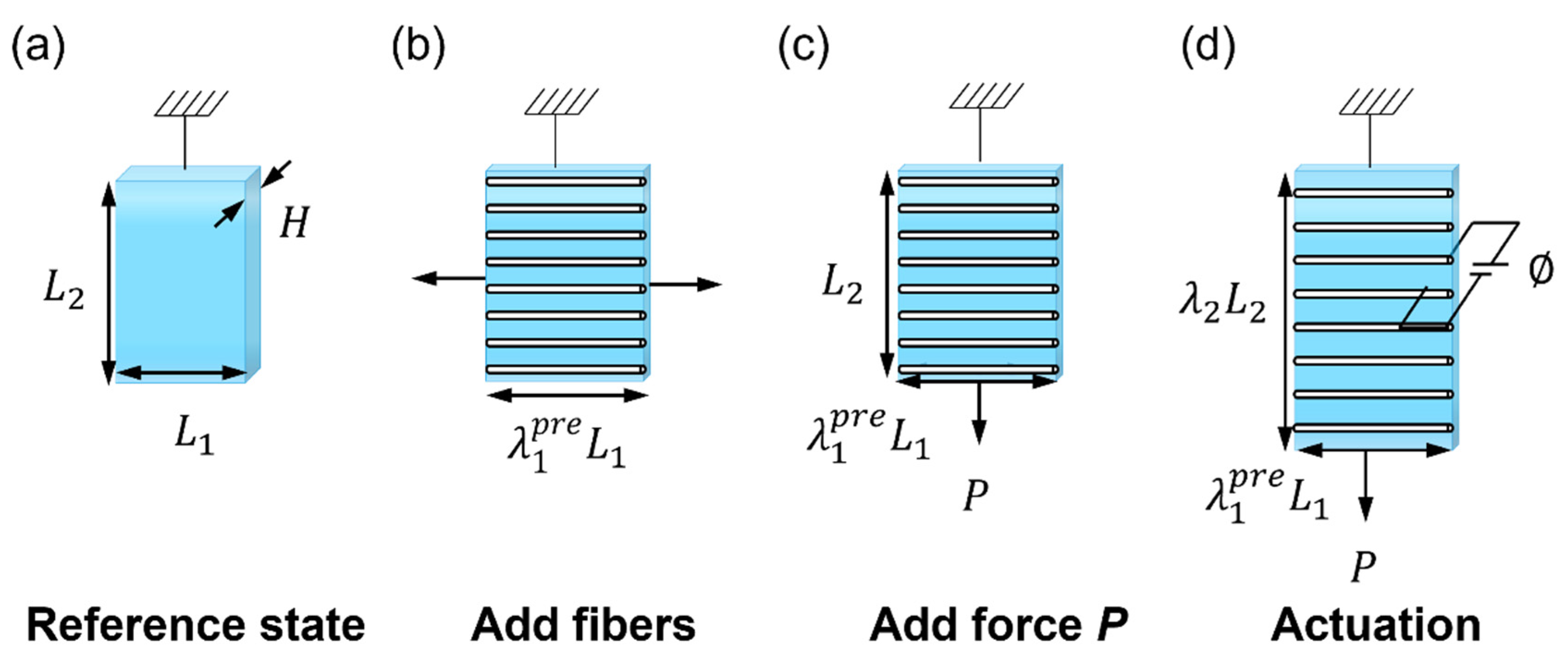
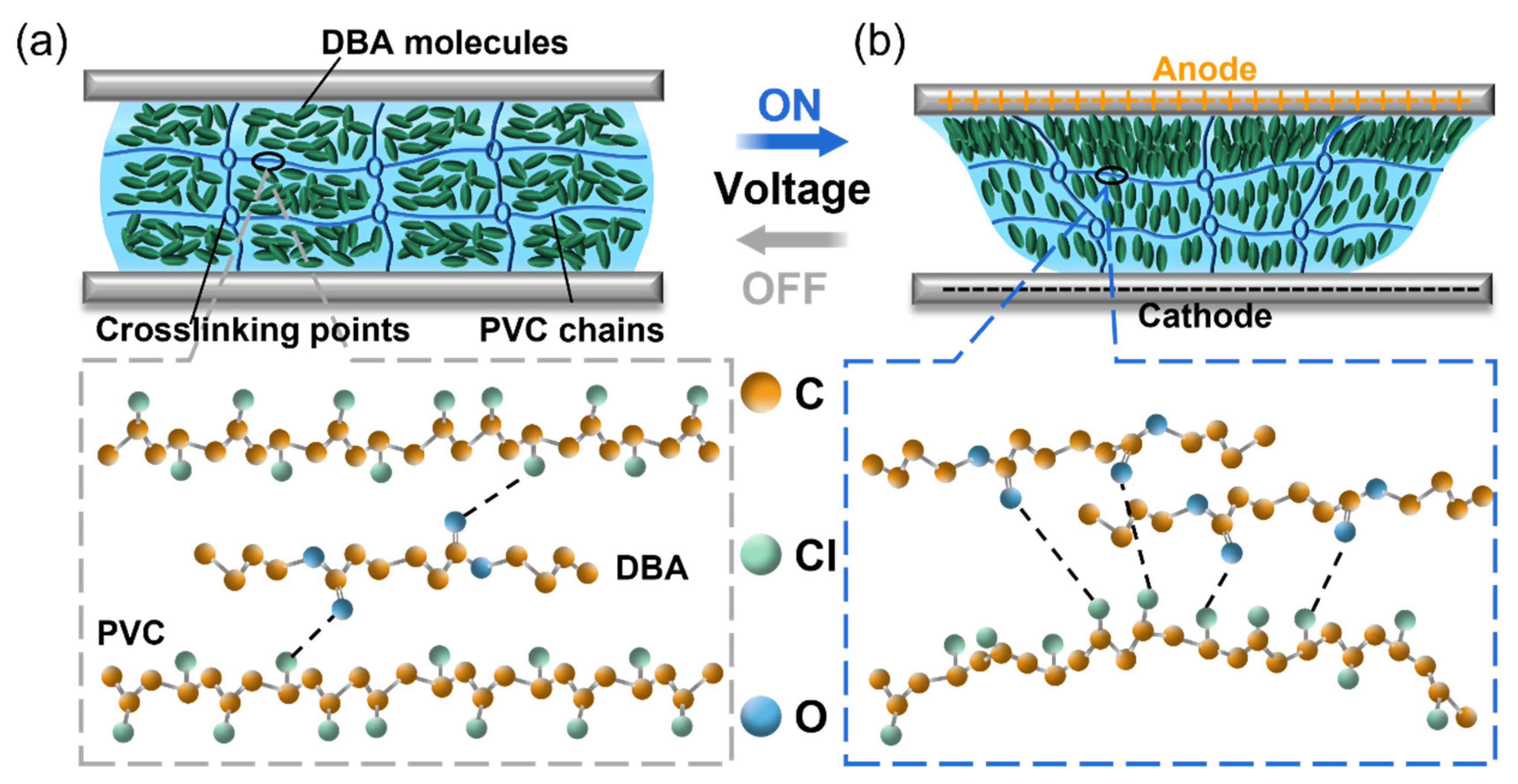
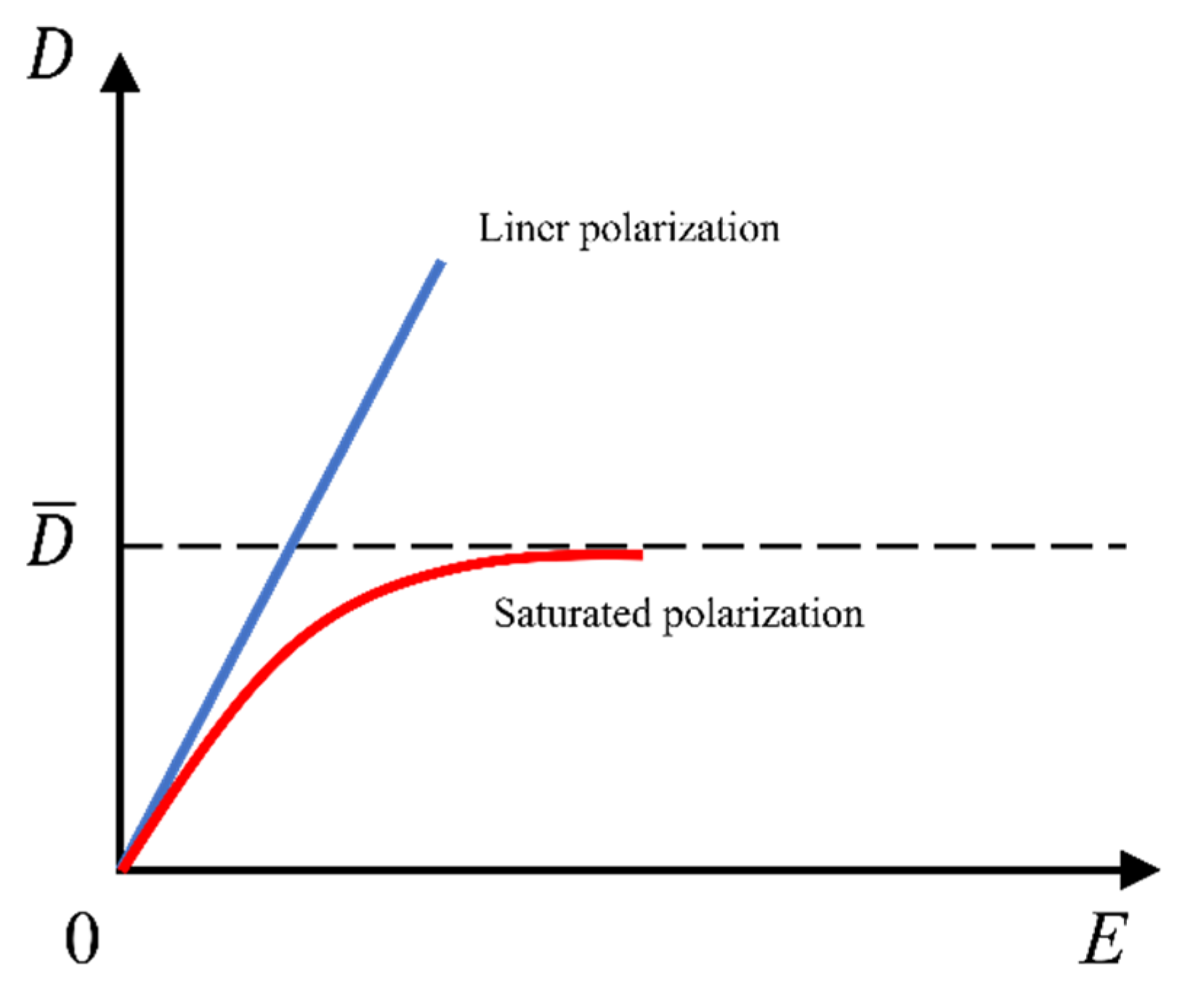


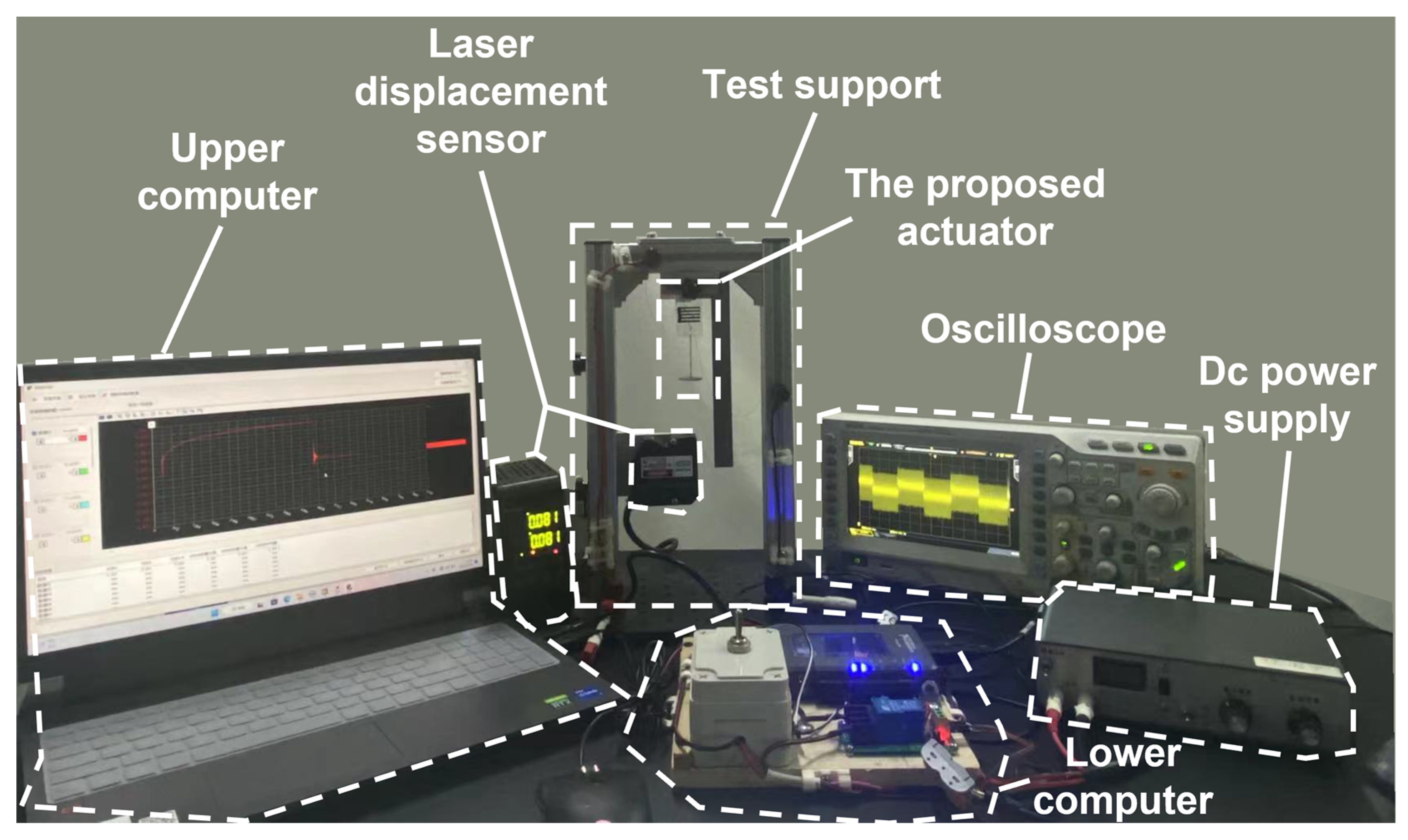

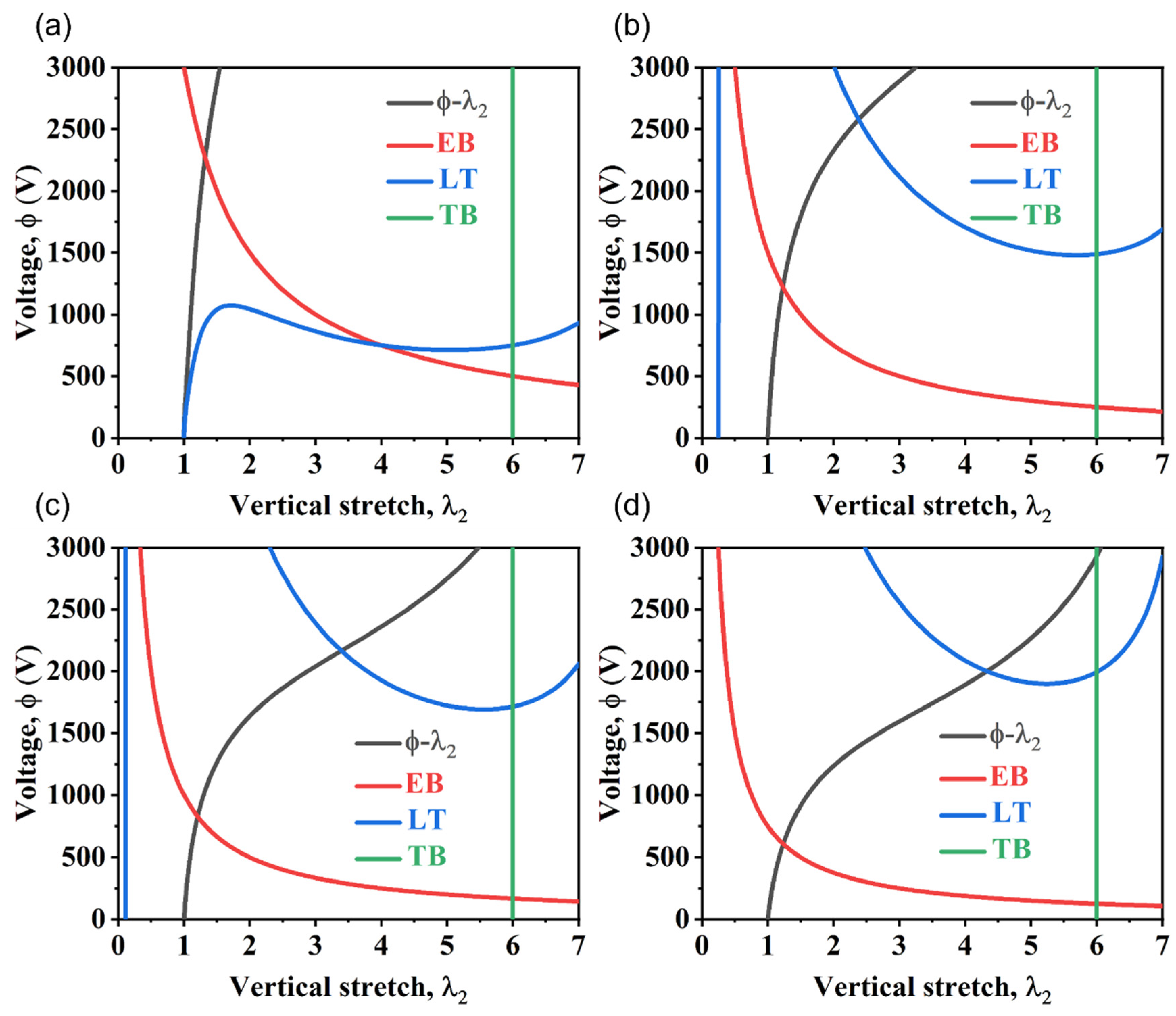


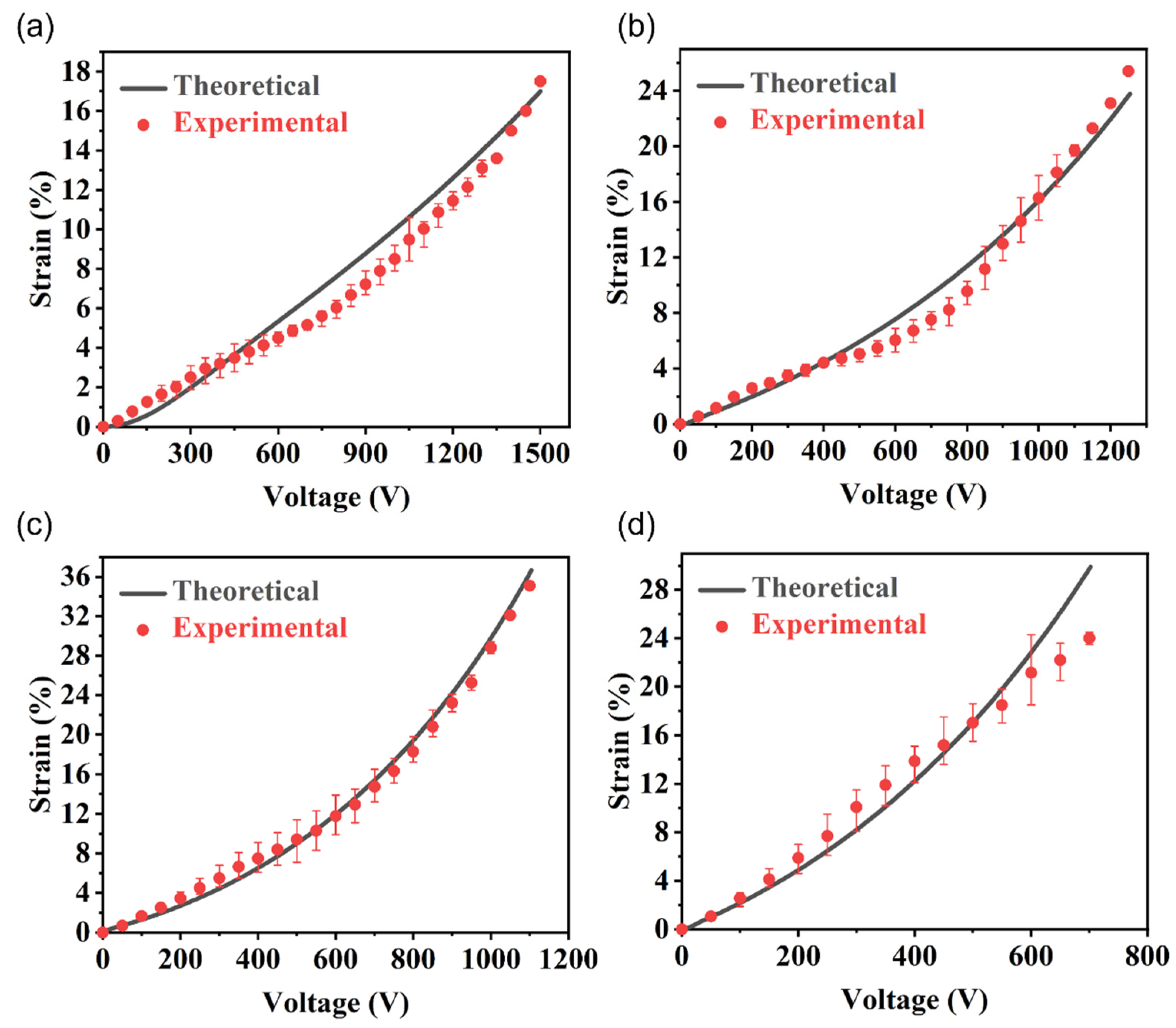
Disclaimer/Publisher’s Note: The statements, opinions and data contained in all publications are solely those of the individual author(s) and contributor(s) and not of MDPI and/or the editor(s). MDPI and/or the editor(s) disclaim responsibility for any injury to people or property resulting from any ideas, methods, instructions or products referred to in the content. |
© 2023 by the authors. Licensee MDPI, Basel, Switzerland. This article is an open access article distributed under the terms and conditions of the Creative Commons Attribution (CC BY) license (https://creativecommons.org/licenses/by/4.0/).
Share and Cite
Li, Y.; Feng, X.; Zhu, L.; Zhang, Z.; Guo, M.; Li, Z.; Li, Y.; Hashimoto, M. Modeling of Fiber-Constrained Planar PVC Gel Actuators. Nanomaterials 2023, 13, 1483. https://doi.org/10.3390/nano13091483
Li Y, Feng X, Zhu L, Zhang Z, Guo M, Li Z, Li Y, Hashimoto M. Modeling of Fiber-Constrained Planar PVC Gel Actuators. Nanomaterials. 2023; 13(9):1483. https://doi.org/10.3390/nano13091483
Chicago/Turabian StyleLi, Yi, Xuxin Feng, Lixiang Zhu, Ziqian Zhang, Mingfei Guo, Zhixin Li, Yanbiao Li, and Minoru Hashimoto. 2023. "Modeling of Fiber-Constrained Planar PVC Gel Actuators" Nanomaterials 13, no. 9: 1483. https://doi.org/10.3390/nano13091483



